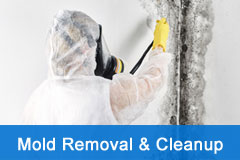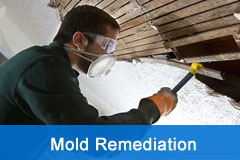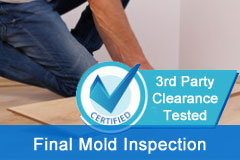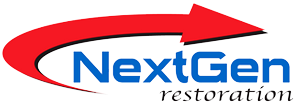Mold Removal & Remediation
Tampa’s Leader in Eliminating Mold and Preventing it from Returning.
Schedule an Estimate


If you have mold, you need trained certified mold experts you can trust!
Properly performing mold removal and remediation must be done someone that is highly trained. Containment and air control, with the ability to eliminate loose particulate from entering in other rooms, or entering your central air / heat system, is the difference from keeping your entire home safe, or cross contaminating the structure and making the issue worse.
- Mold Inspections
- Air Quality & Mold Testing
- Mold Removal & Clean up
- Mold Remediation
- Advanced Technology
- Highly Trained Technicians
- Licensed, Bonded, Insured
- Residential & Commercial

Mold Inspection
A visual inspection determines if advanced mold tests are required. Mold must have moisture to grow so first step is determining if there is a current water leak, or if areas are still wet and need to be dried to prevent mold growth. A site evaluation will be needed.

Mold Removal
If mold is caught early you can prevent further damage but action needs to be taken quickly to mitigation the situation. Our certified techs will go to work quickly to clean up the affected areas and work to keep the mold spores from becoming airborne.

Mold Remediation
Mold remediation is removing the materials that have been damaged by mold and need to be replaced. Most often this can be carpet, padding, wood flooring, drywall or cabinets. Our goal is to restore your home to pre-loss condition as quickly as possible.

Mold Clearance
We provide independent, third party documented Mold Clearance Testing, also know as a Post Remediation Verification (PRV) at the end of every job. This step gives you peace of mind and ensures the mold removal was successful and complete.
Schedule an Estimate
Using Advanced Technology to Prevent Mold from Returning
We use innovative technology to ensure excess moisture has been eliminated to prevent the mold from returning.
D.A.M.P. (Deep Assembly Moisture Profiling) utilizes small penetrating electronic sensors that can detect moisture deep inside the wall assembly, including the wood framing and insulation. The data is collected, automatically documented and easily viewed in real time.
Many water damage and mold remediation companies still rely on inadequate non-penetrating moisture meters and infrared cameras that can only read the surface and partially into the drywall.
Our technology can provide the assurance the moisture issues have been fixed.

Our Customers Say it Best
Common Questions about Mold
Because every mold remediation job is different, our experts need to talk with you and get an idea of how large of an area might be affected and what caused the mold initially. Once we learn a little more about the situation, you can order a mold inspection if needed. We can even provide a comprehensive estimate and work plan for an additional fee, which will be applied to the project if NextGen’s services are utilized.
You won’t need testing to prove you have mold, but you need testing to confirm where the mold has spread, and what it has affected so a detailed scope of work can be written that includes not only all the damage to the building, but also the contents.
If you can smell mold it is actively reproducing and it’s time to get a professional on the project. Often times paint and other materials will mask the presence of mold, this is when sampling becomes necessary. Sampling can also determine the type of mold that is present.
If you’ve recently had water damage and were told it was dry, but now you it smells musty, chances are your assemblies and material are still wet. It takes on average 7 to 15 days to dry most structures. We specialize in this type of mold issues.
There are chemicals, cleaners, fogs and sprays that promise to rid your home of mold. The Institute of Inspection Cleaning and Restoration Certification (IICRC) produces and maintains a consensus-based standard and the Environmental Protection Agency (EPA) wrote a remediation guideline. The IICRC states that vapor based antimicrobials have not been shown to be able to effectively and safely be used for mold remediation.
There are many different types of mold. Some aren’t dangerous, while others lead to chronic and severe health conditions. Stachybotrys for example, is also called “toxic mold” because it produces mycotoxins that cause severe health problems.
If you think you have mold the first sign is a musty odor, peeling or bulging paint, gray, green or black patches and is often seen on ceilings, walls, or flooring. Mold usually grows in places such as under the carpet, behind walls, in attics and even in the bathroom.
Bleach won’t kill mold, it can only make it unable to reproduce. It leaves behind all the toxic components behind that can be inhaled and affect your health. Never use bleach on wood, carpet, drywall, etc., in an attempt to kill mold, you can cause additional damage.

